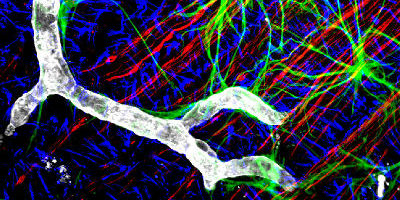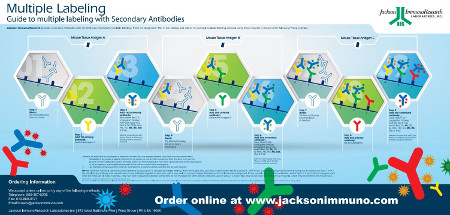
"I have used a wide variety of secondaries and Jackson ImmunoResearch has consistently been the best. The fluorophores are bright and stable and their selective (x reactivity removed) secondaries have always shown species specificity in multiple labeling."
Janet Duerr, Ohio UniversityRating: 5.0
Multiple labeling is the process of sequential immunolabeling to detect multiple antigens by either immunofluorescent or colorimetric IHC/ICC. The successful detection of more than one antigen requires rational experimental design, taking into account a large number of variables accumulated by each of the experimental steps. Here we detail how to set up the multiple labeling experiment and some considerations essential to executing a successful assay.

Selection of antibodies for simultaneous detection of more than one antigen depends on at least two important criteria:
The affinity-purified antibodies marked "ML" (multiple labeling) have been specifically prepared to meet these criteria. They include mouse IgG subclass specific antibodies and antibodies cross-adsorbed (min X) against other species.
| Sample | Mouse | Mouse | Mouse |
|---|---|---|---|
| Antigen | Antigen A | Antigen B | Antigen C |
| Blocking Step | Step 1 | Step 4 | Step 7 |
| 5% Normal Donkey serum to block | 5% Normal Donkey serum to block (if needed) | 5% Normal Donkey serum to block (if needed) | |
| Wash | Wash | Wash | |
| Primary Antibody Step | Step 2 | Step 5 | Step 8 |
| Goat Anti-Antigen A | Rabbit Anti-Antigen B | Rat Anti-Antigen C | |
| Wash | Wash | Wash | |
| Secondary Antibody Step | Step 3 | Step 6 | Step 9 |
| Probe 1 Donkey Anti-Goat IgG (H+L) (min X Ck, GP, Sy Hms, Hrs, Hu, Ms, Rb, Rat Sr Prot) | Probe 2 Donkey Anti-Rabbit IgG (H+L) (min X Bov, Ck, Gt, GP, Sy Hms, Hrs, Hu, Ms, Rat, Shp Sr Prot) | Probe 3 Donkey Anti-Rat IgG (H+L) (min X Bov, Ck, Gt, GP, Sy Hms, Hrs, Hrs, Hu, Ms, Rb, Shp Sr Prot) |
Note: In this example, the secondary antibodies used do not recongnize each other since they are all made in donkey. They have been solid-phase adsorbed so that they do not recognize the other primary antibodies used (min X) in steps, 2, 5, and 8. Also, they do not react with endogenous mouse Ig, which may be present in mouse tissue.
Caution: Do not dilute any antibody with normal serum or mix antibodies together to save time, as this may result in immune complex formation and increased background.
This tool may help in the design your experiment. It will apply the criteria outlined above to identify the potential cross-reactivity between primary antibodies and therefore the minimal cross-reactivity each secondary antibody will require.
Input the species of your sample and the antibodies you intend to use. It is preferential to use the same host species for all the secondary antibodies to minimise the potential for cross-reactivity. Antigen names can be customised by editing the text directly in the table.
Please note that every potential minimal cross-reactivity permutation may not be available, even if indicated by the tool. Goat and Donkey are typically the best secondary antibody host species choice due to the availability of minimal cross-reactivity options.
Fluorescent probes should have the required color separation, read more about this here.
| Sample | - | - | - |
|---|---|---|---|
| Antigen | |||
| Blocking Step | Step 1 | Step 4 | Step 7 |
| - | - | - | |
| Wash | Wash | Wash | |
| Primary Antibody Step | Step 2 | Step 5 | Step 8 |
- |
- |
- |
|
| Wash | Wash | Wash | |
| Secondary Antibody Step | Step 3 | Step 6 | Step 9 |
| - | - | - |
Monovalent Fab fragments of affinity-purified secondary antibodies are offered to cover (block) the surface of immunoglobulins for double labeling primary antibodies from the same host species, or to block endogenous immunoglobulins in tissue sections or on cell surfaces. They can be used for these purposes because Fab fragments have only a single antigen binding site (i.e. they are monovalent).
Sometimes it may be necessary to use a primary antibody from the same species as the sample, for example Mouse on Mouse. In these circumstances secondary antibodies may also detect endogenous immunoglobulin, causing unwanted background. This can be avoided with Fab fragment blocking.
For general blocking purposes, normal serum (5% v/v) from the same species as the secondary antibody host provides efficient background reduction for non-specific, conserved-sequence, and/or Fc-receptor binding.
Specific unwanted reactions with antibodies can be blocked with monovalent Fab fragments of secondary antibodies. This type of blocking is indicated for situations in which the specimen and primary antibodies are of the same species (e.g.mouse on mouse labeling), or when multiple primary antibodies are raised in the same host animal.
Successful multiple labeling depends on the use of probes whose signals can be distinguished by available equipment.
Fluorescence microscopy is a common platform for multiple labeling, since filter sets have been designed to discriminate among the many fluorophores available. Narrow band-pass emission filters are critical for separating signals from multiple fluorophores, suppressing detection of fluorescence from overlapping spectra. When planning a multiple labeling protocol, formulate a dye panel from fluorophores with well separated emission spectra that are compatible with available instrumentation.
| Fluorophore | Excitation Peak (nm) | Emission Peak (nm) |
|---|---|---|
| DyLight™ 405 | 400 | 421 |
| Brilliant Violet 421™ | 407 | 421 |
| Aminomethylcoumarin Acetate, AMCA | 350 | 450 |
| Brilliant Violet 480™ | 436 | 478 |
| Cyanine, Cy™2 | 492 | 510 |
| Alexa Fluor® 488 | 493 | 519 |
| Fluorescein, FITC/DTAF | 492 | 520 |
| Indocarbocyanine, Cy™3 | 550 | 570 |
| Alexa Fluor® 555 | 552 | 572 |
| R-Phycoerythrin, R-PE | many, 488 | 580 |
| Rhodamine Red™-X, RRX | 570 | 590 |
| Alexa Fluor® 568 | 577 | 602 |
| Alexa Fluor® 594 | 591 | 614 |
| Allophycocyanin, APC | many, 650 | 660 |
| Alexa Fluor® 647 | 651 | 667 |
| Indodicarbocyanine, Cy™5 | 650 | 670 |
| Peridinin-Chlorophyll-Protein, PerCP | many, 488 | 675 |
| Alexa Fluor® 680 | 684 | 702 |
| Alexa Fluor® 790 | 792 | 803 |

| Channel | Blue | Cyan | Green | Orange | Red |
|---|---|---|---|---|---|
| Option 1 | DAPI | BV480 | Alexa Fluor 488 | RR-X | Alexa Fluor 647 |
| Option 2 | BV421 | BV480 | Alexa Fluor 488 | RR-X | DRAQ5 |
| Option 3 | BV421 | BV480 | Alexa Fluor 488 | RR-X | Alexa Fluor 647 |
Three examples of dye panels. Options 1 and 2 combine nuclear stains with immunofluorescence. Option 3 shows 5 color immunofluorescence.
Multiple labeling can also be achieved with enzyme-linked antibodies. An antigenic site is labeled with a primary and secondary antibody, followed by color development with a chromogenic substrate such as DAB, TMB or AEC. Additional antigenic sites are labeled sequentially, with different chromogens used for each antigenic site.
For multiple labeling in electron microscopy, different sizes of colloidal gold particles complexed with secondary antibodies allow clear visualization of separate antigenic sites.
Prior to performing a multiple labeling protocol, optimize conditions for each primary/secondary antibody pair. Titrating both the primary and secondary antibody will identify conditions with low background and best positive signal. To demonstrate the specificity of each secondary antibody for its intended primary, attempt to label primaries with the "wrong" secondary antibodies (negative controls).
When using primary antibodies raised in the same host as the specimen species (e.g. mouse on mouse), controls can be used to determine the level of non-specific signal.
For a review of multi-color immunofluorescence labeling with confocal microscopy see Brelje, Wessendorf, and Sorenson, "Multi-color laser scanning confocal immunofluorescence microscopy: Practical application and limitations." In Cell Biological Applications of Confocal Microscopy (Methods in Cell Biology. vol. 38). Ed. B. Matsumoto. Orlando, FL: Academic Press, Inc. 1993, pp. 98-181.

Email marketing@jacksonimmuno.com to receive a hard copy poster by mail.